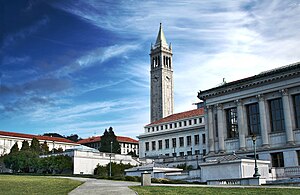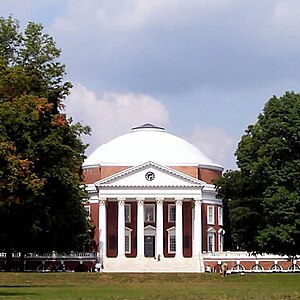| Revision as of 14:54, 18 September 2011 view sourceMabeenot (talk | contribs)Extended confirmed users, Pending changes reviewers8,704 edits deleting excess blank spaces← Previous edit | Revision as of 13:56, 20 September 2011 view source 115.248.50.21 (talk)No edit summaryNext edit → | ||
| Line 5: | Line 5: | ||
| '''Public Ivy''' is a term coined by Richard Moll in his 1985 book ''Public Ivies: A Guide to America's best public undergraduate colleges and universities'' to refer to universities which "provide an ] collegiate experience at a public school price."<ref name=PublicIvys>] in his book ''Public Ivys: A Guide to America's best public undergraduate colleges and universities'' (1985)</ref> Public Ivies are considered, according to the ''Journal of Blacks in Higher Education'', to be capable of "successfully competing with the Ivy League schools in academic rigor... attracting superstar faculty and in competing for the best and brightest students of all races."<ref name=JBHE>{{cite journal |last= |first= |authorlink= |coauthors= |year=2005 |month=Autumn |title=Comparing Black Enrollments at the Public Ivies |journal=Journal of Blacks in Higher Education |volume= |issue= |pages= |id= |url=http://www.jbhe.com/news_views/49_blackenrollment_publicivies.html |accessdate= 2006-09-03 |quote= }}</ref> | '''Public Ivy''' is a term coined by Richard Moll in his 1985 book ''Public Ivies: A Guide to America's best public undergraduate colleges and universities'' to refer to universities which "provide an ] collegiate experience at a public school price."<ref name=PublicIvys>] in his book ''Public Ivys: A Guide to America's best public undergraduate colleges and universities'' (1985)</ref> Public Ivies are considered, according to the ''Journal of Blacks in Higher Education'', to be capable of "successfully competing with the Ivy League schools in academic rigor... attracting superstar faculty and in competing for the best and brightest students of all races."<ref name=JBHE>{{cite journal |last= |first= |authorlink= |coauthors= |year=2005 |month=Autumn |title=Comparing Black Enrollments at the Public Ivies |journal=Journal of Blacks in Higher Education |volume= |issue= |pages= |id= |url=http://www.jbhe.com/news_views/49_blackenrollment_publicivies.html |accessdate= 2006-09-03 |quote= }}</ref> | ||
| NOTE THAT PUBLIC IVY's is just a metaphor and does not not mean they are Ivy league schools. Just in comparison to them. The 8 private schools are the only ORIGINAL Ivy Leagues. | |||
| ==Origins of the term== | ==Origins of the term== | ||
Revision as of 13:56, 20 September 2011



Public Ivy is a term coined by Richard Moll in his 1985 book Public Ivies: A Guide to America's best public undergraduate colleges and universities to refer to universities which "provide an Ivy League collegiate experience at a public school price." Public Ivies are considered, according to the Journal of Blacks in Higher Education, to be capable of "successfully competing with the Ivy League schools in academic rigor... attracting superstar faculty and in competing for the best and brightest students of all races." NOTE THAT PUBLIC IVY's is just a metaphor and does not not mean they are Ivy league schools. Just in comparison to them. The 8 private schools are the only ORIGINAL Ivy Leagues.
Origins of the term
Moll, who earned his Master of Divinity degree from Yale University in 1959, was an admissions officer at Yale, and the director of admissions at Bowdoin College, University of California, Santa Cruz, and Vassar College. He traveled the nation examining higher education and in particular, identified eight public institutions (the same as the number of Ivy League members) which he thought had the look and feel of an Ivy League university. In addition to academic excellence, other factors considered by Moll include visual appearance, age, and school traditions as well as certain other Ivy League characteristics.
The original eight Public Ivies
The original eight Public Ivies as they were listed by Moll in 1985:
- College of William & Mary (Williamsburg, Virginia)
- Miami University (Oxford, Ohio)
- University of California (campuses as of 1985)
- University of Michigan (Ann Arbor)
- University of North Carolina at Chapel Hill
- University of Texas at Austin
- University of Vermont (Burlington)
- University of Virginia (Charlottesville)
The worthy runners-up
Moll also offered in the same book "a list of worthy runners-up" and brief summaries of them:
- University of Colorado at Boulder
- Georgia Institute of Technology
- University of Illinois at Urbana-Champaign
- New College of the University of South Florida (now New College of Florida)
- Pennsylvania State University at University Park
- University of Pittsburgh
- State University of New York at Binghamton (also called Binghamton University)
- University of Washington
- University of Wisconsin–Madison
Greenes' Guides
The more recent and expansive Greene's list (including a list of approximately 30 schools) had one focus alone: public schools with academic quality comparable to an Ivy League institution.
The Public Ivies according to Greene's Guides
A later book titled The Public Ivies: America's Flagship Public Universities (2001) by Howard and Matthew Greene of Greene's Guides expanded upon the first list (italicized below) to include 30 colleges and universities. The table below is organized by region, and colleges are listed in alphabetical order.
Institutional comparisons
Academic comparisons and rankings
Several schools considered as "Public Ivies" are consistently ranked among the top schools in the multitude of surveys on American colleges and universities undertaken by U.S. News & World Report. For instance, half of the top 12 ranked national universities for undergraduate teaching in U.S. News and World Report are of the original Public Ivies listed by Moll. Public Ivies can be found in the top ten ranked graduate schools in business, education, engineering, law, and medicine.
Athletic comparisons
One sharp distinction between the Ivy League and most "Public Ivies" is their participation in intercollegiate athletics. One of the Ivy League's distinguishing characteristics is its prohibition on the awarding of athletic scholarships (athletes may only receive the same financial aid to which they would be entitled even if they did not play a sport). In contrast, many of the "Public Ivies" participate in major athletic conferences such as the Big East, Big Ten, Big 12, ACC, SEC, or Pac-12, and award athletic scholarships. These schools sometimes rely on profits, if any, from large-scale football and men's basketball programs to support the athletic department as a whole.
See also
- Black Ivy League
- Colonial colleges
- Flagship university
- Hidden Ivies: Thirty Colleges of Excellence
- Ivy League
- Little Three
- Little Ivies
- Seven Sisters
- Southern Ivies
References and other resources
Citations
- Richard Moll in his book Public Ivys: A Guide to America's best public undergraduate colleges and universities (1985)
- ^ "Comparing Black Enrollments at the Public Ivies". Journal of Blacks in Higher Education. 2005. Retrieved 2006-09-03.
{{cite journal}}: Cite has empty unknown parameter:|coauthors=(help); Unknown parameter|month=ignored (help) - ^ Branch, Mark Alden (2000). "Deciphering the Admissions Map". Yale Alumni Magazine. 109 (11). Retrieved 2008-02-09.
¶16: But Richard Moll '59MDiv, a former Yale admissions officer who later oversaw admissions at Bowdoin and Vassar, thinks Yale still is not as visible as it should be. "Yale has not had the presence at grassroots admissions and counseling conferences that Harvard and Stanford have," says Moll, author of Playing the Selective College Admissions Game.
{{cite journal}}: Cite has empty unknown parameter:|coauthors=(help); Unknown parameter|month=ignored (help) - Pierce, Kenneth M. (24 November 1980). "Dr. Fix-It Goes to Santa Cruz". Time. Retrieved 2008-02-09.
Trouble in paradise as "the touchy-feely school" sings the blues – Richard Moll, 45, a tweedy graduate of Yale's Divinity School, has become a Dr. Fix-It for colleges that complain of sagging enrollment.
- Paul Marthers, Dean of Admission. "Admissions Messages vs. Admissions Realities". Office of Admissions. Reed College. Retrieved 2008-02-09.
- In Moll's book, he refers to the entire UC system
- Moll, Richard (1985). The Public Ivys: A Guide to America's Best Undergraduate Colleges and Universities. Viking Penguin Inc. p. xxvi. 0-670-58205-0
- Greenes' Guides: The Public Ivies (accessed on May 16, 2007); see also .
- U.S. News and World Report. "Best Colleges: Undergraduate Teaching at National Universities". Retrieved 2 August 2010.
- U.S. News and World Report. "Best Graduate Schools". Retrieved 2 August 2010.
Books
- Greene, Howard (2001). The Public Ivies: America's Flagship Public Universities. New York: HarperCollins. ISBN 006093459X.
{{cite book}}: Unknown parameter|coauthors=ignored (|author=suggested) (help) - Greene, Howard (2000). Hidden Ivies: Thirty Colleges of Excellence. New York: HarperCollins. ISBN 0060953624.
{{cite book}}: Unknown parameter|coauthors=ignored (|author=suggested) (help) - Moll, Richard (1985). The Public Ivies: A Guide to America's best public undergraduate colleges and universities. New York: Penguin (Viking). ISBN 0140093842.
- Robert Franek ... (2006). The Best 361 Colleges, 2007 Edition. Princeton, New Jersey: Princeton Review. ISBN 0375765581.
| Public Ivy universities | |
|---|---|
| Richard Moll's 1985 list | |
| Original eight | |
| "Worthy runners-up" | |
| Greenes' Guides 2001 list | |
| Eastern | |
| Western | |
| Great Lakes | |
| Southern | |